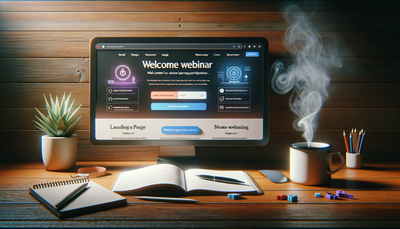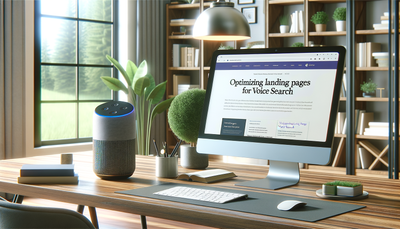Crafting Compelling Call-to-Actions for Your Landing Page
Crafting compelling call-to-actions (CTAs) is essential for any successful landing page. These powerful elements can make the difference between a visitor leaving your site or taking the desired action. In this comprehensive guide, we'll explore the art of creating irresistible CTAs that drive conversions. From copywriting techniques that spark interest to button design best practices that catch the eye, we'll cover everything you need to know. We'll also delve into strategic placement strategies to ensure your CTAs get the attention they deserve. Whether you're new to CTA creation or looking to refine your skills, this article will provide valuable insights to boost your conversion rates and achieve your marketing goals.Table of Contents:

Understanding the Importance of CTAs
Call-to-actions are the gatekeepers of conversion on your landing page. They guide visitors towards the next step in their journey, whether it's making a purchase, signing up for a newsletter, or downloading a resource. Effective CTAs not only tell users what to do but also why they should do it. They create a sense of urgency and highlight the value proposition of taking action. By mastering CTA creation, you can significantly improve your conversion rates and overall marketing success.Remember, a well-crafted CTA is more than just a button or a link. It's a persuasive element that combines psychology, design, and strategic placement to motivate users. As we explore various aspects of CTA creation, keep in mind that testing and optimization are key to finding what works best for your specific audience and goals.
Do you need a website? Want to build a website but don't know where to start? Our website builder is the perfect solution. Easy to use, and with the ability to customize to fit your business needs, you can have a professional website in no time.
Copywriting Techniques for Compelling CTAs
The words you choose for your CTA can make or break its effectiveness. Start by using action-oriented verbs that clearly communicate what will happen when the user clicks. Instead of generic phrases like 'Submit' or 'Click Here,' opt for specific actions like 'Get Your Free Trial' or 'Start Saving Now.' These create a clearer picture of the outcome and can increase click-through rates.Incorporate urgency and scarcity into your CTA copy to motivate immediate action. Phrases like 'Limited Time Offer' or 'Only 5 Spots Left' can create a fear of missing out (FOMO) that prompts users to act quickly. Additionally, focus on the benefits to the user rather than the features of your product or service. 'Boost Your Productivity' is more compelling than 'Try Our Software.' Lastly, keep your CTA copy concise and to the point. Aim for no more than 5-7 words to maintain clarity and impact.
Button Design Best Practices
The visual design of your CTA button plays a crucial role in attracting attention and encouraging clicks. Size matters - make your button large enough to be easily noticed, but not so large that it overwhelms other elements on the page. Color is another important factor. Choose a color that contrasts with the surrounding elements to make the button stand out. However, ensure it still aligns with your overall color scheme and brand identity.Shape and style can also influence CTA effectiveness. Rounded corners on buttons are often perceived as more approachable and clickable compared to sharp edges. Consider adding subtle animations or hover effects to make the button more interactive and engaging. White space around the button is crucial for drawing focus - don't crowd your CTA with other elements. Lastly, ensure your button looks clickable. Use design cues like shadows or gradients to give it a 3D appearance that invites interaction.
Building a website with SITE123 is easy
Strategic Placement for Maximum Impact
Where you place your CTAs on the landing page can significantly impact their performance. The traditional approach is to position the main CTA above the fold, ensuring it's visible without scrolling. However, don't limit yourself to just one CTA. Strategically place additional CTAs throughout the page, especially after presenting key benefits or addressing potential objections.Consider using a floating CTA that remains visible as users scroll, providing a constant opportunity to take action. For longer landing pages, include CTAs at natural breakpoints in the content. Pay attention to the user's reading pattern - placing CTAs at the end of paragraphs or sections can be effective as it coincides with natural pauses in the user's attention. Always ensure your CTAs are in logical locations that align with the user's decision-making process.
Optimizing CTAs for Mobile Users
With the increasing prevalence of mobile browsing, it's crucial to optimize your CTAs for smaller screens. Ensure your buttons are large enough to be easily tapped with a finger - a minimum size of 44x44 pixels is recommended. Consider using full-width buttons on mobile to maximize the clickable area. Adjust your copy if necessary to fit comfortably on mobile screens without wrapping or truncation.Pay special attention to the placement of CTAs on mobile. Since screen space is limited, prioritize the most important CTA and ensure it's visible without requiring excessive scrolling. Use white space effectively to prevent accidental clicks on wrong elements. Lastly, test your CTAs across various devices and screen sizes to ensure a consistent and user-friendly experience for all visitors.
A/B Testing and Continuous Improvement
The key to truly effective CTAs lies in continuous testing and optimization. Implement A/B testing to compare different versions of your CTAs and identify what resonates best with your audience. Test various elements including copy, design, color, size, and placement. Don't be afraid to try bold variations - sometimes the most significant improvements come from unexpected changes.Analyze your results carefully, looking beyond just click-through rates. Consider the impact on overall conversion rates and revenue. Remember that what works for one landing page or audience may not work for another, so avoid generalizing results too broadly. Regular testing and refinement will help you stay ahead of changing user preferences and keep your CTAs performing at their best.





